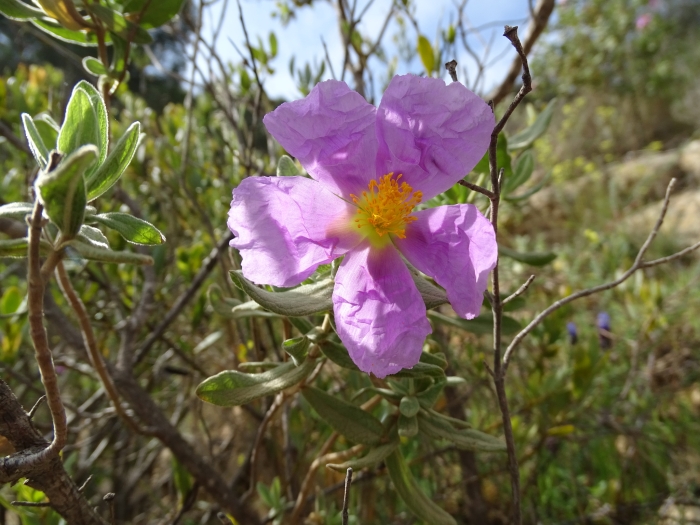Grey-Leaved Cistus
(Cistus albidus)
Grey-Leaved Cistus (Cistus albidus)
/
/

Alfonso Garmendia
CC BY 4.0
Image By:
Alfonso Garmendia
Recorded By:
Copyright:
CC BY 4.0
Copyright Notice:
Photo by: Alfonso Garmendia | License Type: CC BY 4.0 | License URL: http://creativecommons.org/licenses/by/4.0/ | Rights Holder: Alfonso Garmendia | Publisher: iNaturalist | Date Created: 2022-04-10T10:27:16-07:00 |

























Estimated Native Range
Summary
Cistus albidus, commonly known as Grey-leaved Cistus, is a shrubby perennial herb native to the Mediterranean region, specifically southwestern Europe and western North Africa. It typically grows up to 3 feet tall and wide, with a dense, rounded form. The leaves are oblong to elliptical, covered in short hairs that lend a distinctive greyish-white appearance to the foliage. From late spring to early summer, it produces showy pink to purple flowers, each with five petals, arranged in cymes. These flowers are particularly attractive to bees and other pollinators.
Grey-leaved Cistus is valued for its drought tolerance and the silvery texture of its foliage, which can add contrast to garden plantings. It is commonly used in rock gardens, as part of a Mediterranean garden scheme, or in xeriscaping due to its low water requirements. This plant prefers well-drained soils, tolerates poor fertility, and thrives in full sun, reflecting its adaptation to the dry, sunny conditions of its native habitat. While generally low-maintenance, it can be susceptible to root rot if overwatered or planted in poorly draining soils. It is not known for aggressive roots or significant disease problems, but it can be short-lived and may need replacing after several years.CC BY-SA 4.0
Grey-leaved Cistus is valued for its drought tolerance and the silvery texture of its foliage, which can add contrast to garden plantings. It is commonly used in rock gardens, as part of a Mediterranean garden scheme, or in xeriscaping due to its low water requirements. This plant prefers well-drained soils, tolerates poor fertility, and thrives in full sun, reflecting its adaptation to the dry, sunny conditions of its native habitat. While generally low-maintenance, it can be susceptible to root rot if overwatered or planted in poorly draining soils. It is not known for aggressive roots or significant disease problems, but it can be short-lived and may need replacing after several years.CC BY-SA 4.0
Plant Description
- Plant Type: Shrub
- Height: 2.75-3.25 feet
- Width: 2-3 feet
- Growth Rate: Moderate
- Flower Color: Purple
- Flowering Season: Spring, Summer
- Leaf Retention: Evergreen
Growth Requirements
- Sun: Full Sun
- Water: Low
- Drainage: Fast, Medium
Common Uses
Deer Resistant, Drought Tolerant, Groundcover, Low Maintenance, Rock Garden, Showy Flowers, Street Planting
Natural Habitat
Native to the Mediterranean region, specifically southwestern Europe and western North Africa
Other Names
Common Names: Grey-Leaf Cistus , White-Leaf Rock-Rose , White Rockrose , Weißliche Zistrose
Scientific Names: Cistus albidus , Cistus albeerensis var. barcinonensis , Cistus albidus f. albus , Cistus albidus f. platyphyllus , Cistus albidus f. typicus , Cistus albidus var. albus , Cistus albidus var. angustifolius , Cistus albidus var. attenuatifolius , Cistus albidus var. grandifolius , Cistus albidus var. latifolius
GBIF Accepted Name: